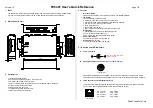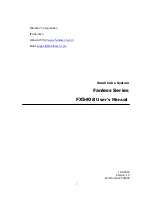
User Manual
Doc. Number: ESO-323064
Doc. Version: 2
Released on:
Page:
59 of 82
Document Classification: Public
SEQ.METROLOGY.ST
=T) if your science requires highly reproducible positioning of the
echellogram on the detectors.
NGS details:
·
Target = AO guide star
(TSF:
SEQ.NGS.ISTARGET
) is a flag to be set to YES
(i.e.,
SEQ.NGS.ISTARGET
=T, default value) when star used for the adaptive optics is
also the science target of the observations, else the flag must be set to NO (i.e.,
SEQ.NGS.ISTARGET
= F).
·
RA/DEC of AO guide star
(TSF:
SEQ.NGS.ALPHA, SEQ.NGS.DELTA
) RA and
DEC coordinates of the NGS. If the NGS is also the target (i.e.,
SEQ.NGS.ISTARGET
=T)
then the user does not need to provide the star coordinates and these two parameters can
be left untouched to their default value (i.e., 00:00:00). See §4.2.1.2 for the maximum
allowed distance between the target and the NGS.
When the NGS is the target the user needs to provide the NGS coordinates.
Note that for the differential tracking case the NGS coordinates are provided through the
tracking table.
·
AO guide star: B-R color value
(TSF:
SEQ.NGS.COLOR
) gives the B-R colour
of the
NGS. This parameter is needed for accurate correction of the differential refraction
between the wavelength used for the observations and the effective wavelength of the
wavefront sensor (see §4.2.1.4).
·
NGS MAG
(TSF:
SEQ.NGS.MAG
) refers to the magnitude of the NGS in the R passband.
See §4.2.1.3 for the allowed range.
·
AO guide stars: FWHM (arcsec)
(TSF:
SEQ.NGS.FWHM
) gives the FWHM of the
NGS in arcsec used to optimize the AO system diaphragm. This diaphragm is set as a
function of the seeing, and as such it optimizes the amount of light received from the object
with respect to the amount of background light from the sky. If the NGS is a point source,
the FWHM is best left to zero, such as only the seeing will be taken into account. Only if the
NGS is significantly extended with respect to the seeing then this parameter should be set
to equal to the FWHM of the object in arcseconds.
·
AO guide star: Minimum S/N
(TSF:
SEQ.NGS.SNR
) refers to the required signal-
to-noise ratio that MACAO needs on the wavefront sensor to be able to close the loop.
The default value (i.e., 1000) is fine for most cases, except for the faintest objects that the
MACAO can acquire, in which case a smaller value is to be given.
·
Use the last sky measurement for WFS
(TSF:
SEQ.NGS.USELASTSKY
) is a
flag, which if set to
yes
(i.e.,
SEQ.NGS.USELASTSKY
=T), then MACAO will not repeat the
sky measurement for the wavefront sensor. The sky measurement is used to determine
the SNR of the wavefront sensor flux. The default value (i.e., YES) is adequate for bright
AO stars (R < 10). For fainter targets, the parameter should be set to NO. Note that in this
case, the parameters
SEQ.NGS.SKYALPHA
and
SEQ.NGS.SKYDELTA
should be
determined with care if observations take place in crowded fields.
















































